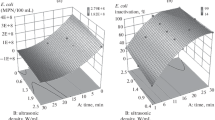Abstract
The objective of this work is to evaluate the effects of ultrasound waves on the viability of bacteria that usually occur in mineral waters such as spa thermal waters. The study was carried out at a constant temperature of 309.65 K on two Gram-positive bacteria (Staphylococcus epidermidis, Staphylococcus warneri) and two Gram-negative bacteria (Pseudomonas aeruginosa, Proteus mirabilis) with a concentration of 106 CFU mL−1. A commercial ultrasonic bath was used. The effects of the ultrasounds were analysed using a microcalorimetric technique. The microcalorimetric bacterial growth curves were obtained and, stemming from said curves, the heat released by microorganisms during a culture time of 24 h was calculated. The values of the heat released in the samples treated and untreated with ultrasounds were compared. The ultrasound treatment appears to be effective in inhibiting the growth of the two Gram-positive bacteria, but not in the case of the Gram-negative, which presented greater resistance at the same experimental conditions. This study also shows microcalorimetry as an efficient technique to determine the effect of ultrasound waves on bacterial growth.





Similar content being viewed by others
References
Ahmed FIK, Russell C (1975) Synergism between ultrasonic waves and hydrogen peroxide in the killing of micro-organisms. J Appl Bacteriol 39(1):31–40
Alliger H (1975) Ultrasonic disruption. Am Lab 10:75–85
Calvet E, Prat H (1956) Microcalorimétrie: applications physico-chimiques et biologiques. Masson et Cie Editeurs, Paris
Cameron M, McMaster LD, Britz TJ (2008) Electron microscopic analysis of dairy microbes inactivated by ultrasound. Ultrason Sonochem 15(6):960–964
Chunmei D, Jiabo W, Weijun K, Cheng P, Xiaohe X (2010) Investigation of anti-microbial activity of catechin on Escherichia coli growth by microcalorimetry. Environ Toxicol Pharmacol 30(3):284–288
Drakopoulou S, Terzakis S, Fountoulakis MS, Mantzavinos D, Manios T (2009) Ultrasound-induced inactivation of gram-negative and gram-positive bacteria in secondary treated municipal wastewater. Ultrason Sonochem 16(5):629–634
Gao S, Lewis GD, Ashokkumar M, Hemar Y (2014) Inactivation of microorganisms by low-frequency high-power ultrasound: 1. Effect of growth phase and capsule properties of the bacteria. Ultrason Sonochem 21(1):446–453
Gómez-López MD, Bayo J, García-Cascales MS, Angosto JM (2009) Decision support in disinfection technologies for treated wastewater reuse. J Clean Prod 17(16):1504–1511
James AM (1987) Calorimetry. Past, present and future in thermal and energetic studies of cellular biological systems. IOP Publishing Ltd, Bristol
Joyce E, Phull SS, Lorimer JP, Mason TJ (2003) The development and evaluation of ultrasound for the treatment of bacterial suspensions. A study of frequency, power and sonication time on cultured Bacillus species. Ultrason Sonochem 10(6):315–318
Lago N, Legido JL, Paz Andrade MI, Arias I, Casás LM (2011) Microcalorimetric study on the growth and metabolism of Pseudomonas aeruginosa. J Therm Anal Calorim 105(2):651–655
Leighton TG (1994) The Acoustic Bubble. Academic Press, San Diego
Ma J, Qi WT, Yang LN, Yu WT, Xie YB, Wang W, Ma XJ, Xu F, Sun LX (2007) Microcalorimetric study on the growth and metabolism of microencapsulated microbial cell culture. J Microbiol Method 68(1):172–177
Maraver F, Armijo F (2010) Vademecum II de aguas mineromedicinales españolas. Editorial Complutense, Madrid
Monsen T, Lövgren E, Widerström M, Wallinder L (2009) In vitro effect of ultrasound on bacteria and suggested protocol for sonication and diagnosis of prosthetic infections. J Clin Microbiol 47(8):2496–2501
Nesaratnam ST, John Wase DAJ, Blakebrough N (1982) The susceptibility to ultrasonic disintegration of Klebsiella pneumonia NCTC 418. Eur J Appl Microbiol Biotechnol 15(1):56–58
Olvera M, Eguía A, Rodríguez O, Chong E, Pillai SD, Ilangovan K (2008) Inactivation of Cryptosporidium parvum oocysts in water using ultrasonic treatment. Bioresour Technol 99(6):2046–2049
Paleologou A, Marakas H, Xekoukoulotakis NP, Moya A, Vergara Y, Kalogerakis N, Gikas P, Mantzavinos D (2007) Disinfection of water and wastewater by TiO2 photocatalysis, sonolysis and UV-C irradiation. Catal Today 129:136–142
Patil MN, Pandit AB (2007) Cavitation - A novel technique for making stable nano-suspensions. Ultrason Sonochem 14(5):519–530
Paz Andrade MI (1967) Les développements récents de la microcalorimétrie et de la thermogenèse, 1st edn. CRNS, Paris
Rivero NL, Legido JL, Santos IA, Casás LM (2012) Comparative study of microcalorimetric behavior of Escherichia coli, Proteus mirabilis and Klebsiella pneumoniae. Pol J Microbiol 61(3):199–204
Rivero NL, Soto JLL, Santos IA, Casás LM (2013) Differentiation between Staphylococcus aureus and Staphylococcus epidermidis using microcalorimetry. Int J Thermophys 34(6):1039–1048
Scherba G, Weigel RM, O’Brien WD (1991) Quantitative assessment of the germicidal efficacy of ultrasonic energy. Appl Environ Microbiol 57(7):2079–2084
Shah YT, Pandit AB, Moholkar VS (1999) Cavitation reaction engineering. Plenum Publishers, New York
Singer AJ, Coby CT, Singer AH, Thode HC, Tortora GT (1999) The effects of low-frequency ultrasound on Staphylococcus epidermidis. Curr Microbiol 38(3):194–196
Thacker J (1973) An approach to the mechanism of killing of cells in suspension by ultrasound. Biochim Biophys Acta 304(2):240–248
Villamiel M, De Jong P (2000) Inactivation of Pseudomonas fluorescens and Streptococcus thermophilus in Trypticase Soy Broth and total bacteria in milk by continuous-flow ultrasonic treatment and conventional heating. J Food Eng 45(3):171–179
Acknowledgments
We thank María Perfecta Salgado González and Sofía Baz Rodríguez for their collaboration with the technical measures. We are also thankful for the financial support provided by the projects EM 2012/141, C269 131H 64502, CN 2012/285, and “Agrupación estratéxica de Biomedicina (INBIOMED)” by “Xunta de Galicia” and the project FIS 2011-23322 funded by Ministry of Science and Innovation of Spain. All these projects are co-financed with FEDER funds.
Author information
Authors and Affiliations
Corresponding author
Rights and permissions
About this article
Cite this article
Vázquez, C., Iglesias, T.P., Mourelle, L. et al. Ultrasonic bacterial treatment of mineral waters: a study on S. epidermidis, S. warneri, P. aeruginosa and P. mirabilis . Environ Earth Sci 73, 2863–2868 (2015). https://doi.org/10.1007/s12665-014-3488-y
Received:
Accepted:
Published:
Issue Date:
DOI: https://doi.org/10.1007/s12665-014-3488-y




